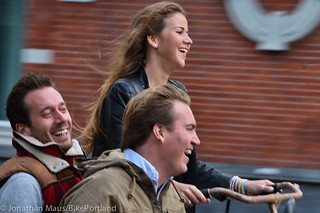
you’re doing something right.
(Photos © J. Maus/BikePortland)
Like I mentioned in my last post, I had a few “free” days in Amsterdam after my time in Copenhagen and before the official study tour began today (more on that later). Since I’ll be back in Amsterdam to do all the wonky stuff later this week, I spent those free days doing what I like best: wandering around and observing people on bikes. I think you learn a lot about a city’s bike culture simply by watching how its residents use their bicycles.
What I saw in Amsterdam was the most sociable (and stylish) cycling imaginable. It was really astounding to see how the bicycle is such a key element in the social fabric.
In great bicycle cities, the quality of the bike network creates a riding environment suited to conversation. In fact, in both Denmark and the Netherlands, bikeways are designed specifically with socializing in mind. In the Netherlands, fostering a healthy “social being” is a core design element. On busy streets, completely segregated cycle tracks are wide enough for side-by-side riding (Copenhagen has some 16-foot wide cycle tracks with “social” lanes (a.k.a. passing lanes)). And on lower volume streets, traffic is so calm it’s easy — and quite nice actually — to chat while you ride.
The maneuverability of bicycles is also a factor. In a good bike city, users of bicycles can take their vehicle nearly everywhere. Unlike a car, with its massive physical footprint and public transport, which runs on fixed routes, it’s easy to stop a bicycle if something catches your eye or pull over and chat with a friend. Social cycling is also possible here because most people have a fully upright riding position. If you look at some of my photos from the belly up, the subjects look like they could be walking.
Another thing that works into the social cycling mix is that people here are extremely skilled at riding. They can have conversations (on the phone or with a friend next to them) while pedaling through a chaotic intersection rife with bumbling tourists, trams, cars, buses, and so on.
These social interactions that cycling makes possible have a profound positive impact on cities. We learned from a Dutch cycling expert today about the concept of “experience as an economic tool.” That is, cities with attractive public space are full of people having experiences and those experiences lead to economic activity. And it’s not just felt by people who are riding. Cities in the Netherlands with high bike mode shares have vibrant sidewalk cafes with tables and chairs facing right onto the street. The main reason it’s so pleasant to sit and talk at places like that is because there are so few cars rumbling by (in Amsterdam, bicycling is the majority mode of travel).
In Portland we have a strong social element to cycling — but it happens mostly at our events and destinations rather than in the bike lanes themselves. We don’t socialize while riding like they do here. Why is that? Are we too concerned with our safety? Are we just not skilled enough to carry on a conversation without getting distracted? Or is it because most people’s bikes in the U.S. require them to be hunched over? What do you think?
Oh, and the fact that everyone in Amsterdam is so stylishly dressed is just icing on the cake. Check out more social and stylish images below…
— See more of my coverage from Europe here.


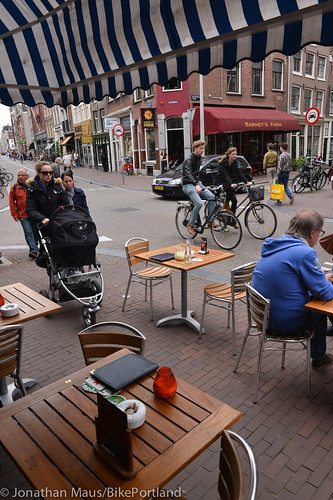
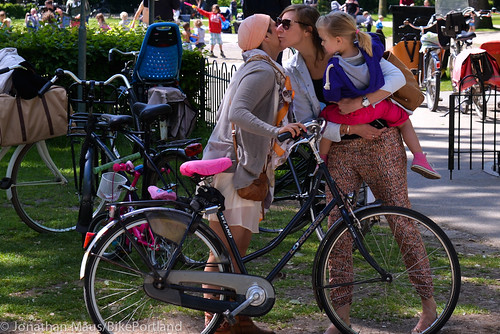
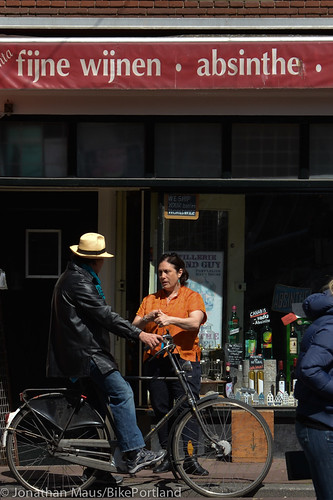

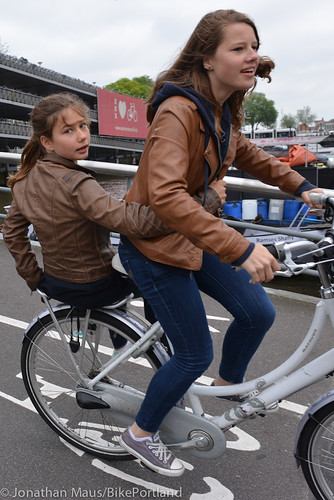
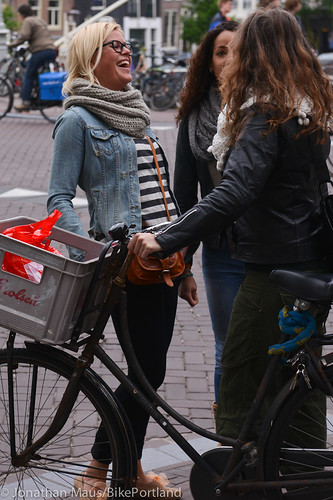
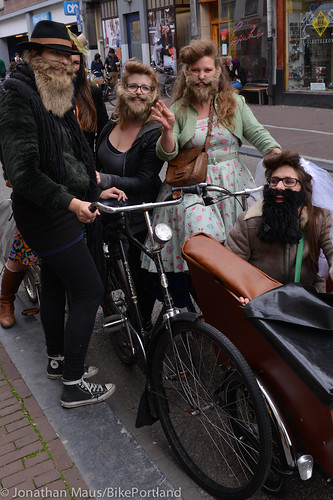
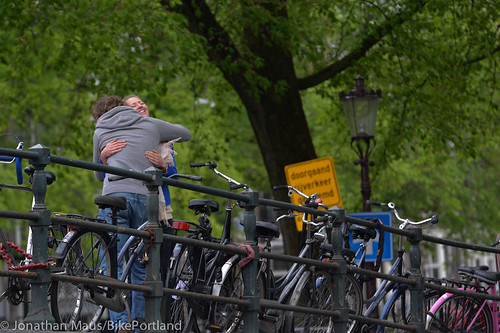
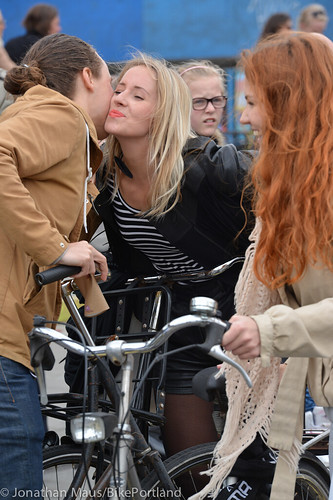
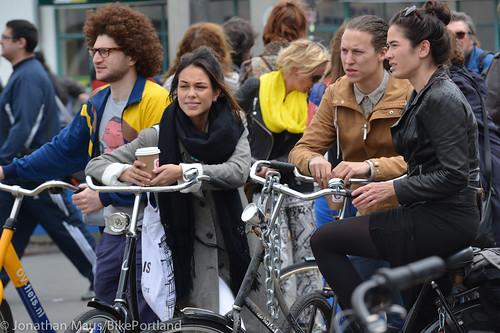
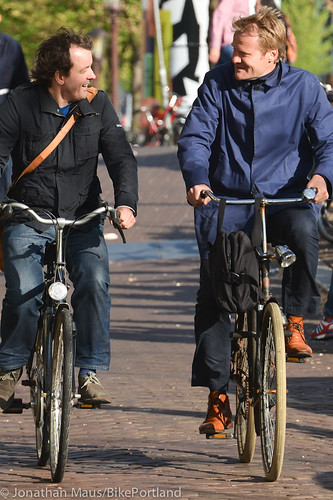

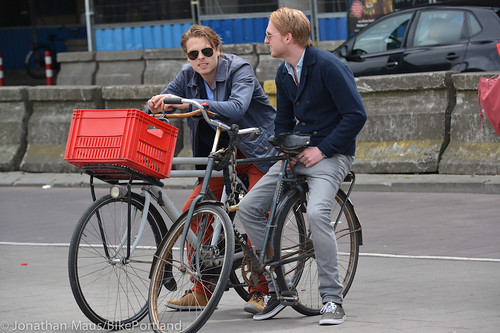
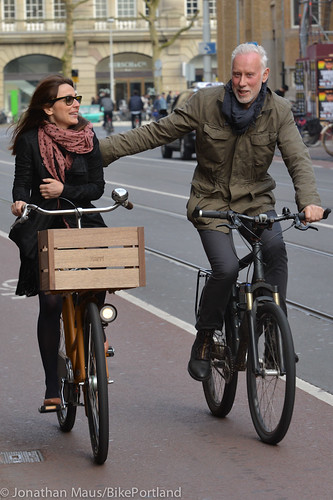
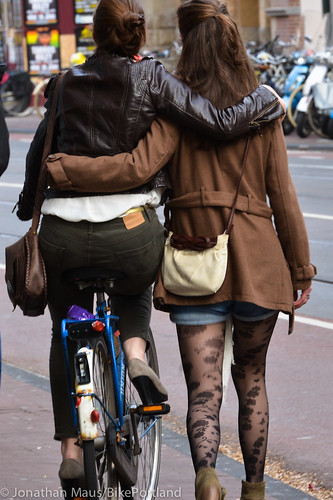
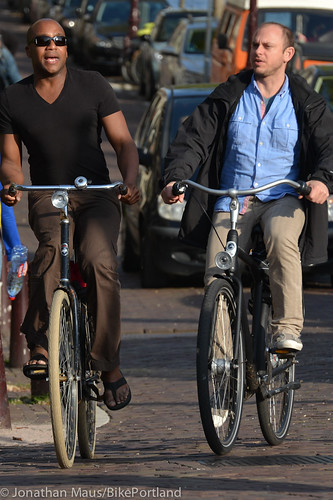
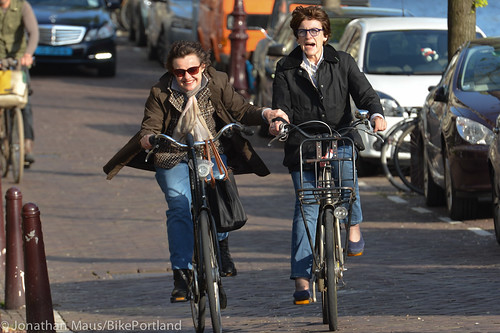

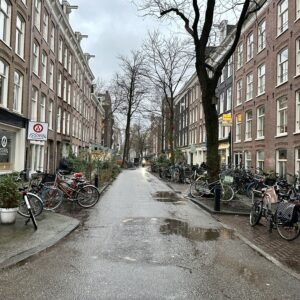
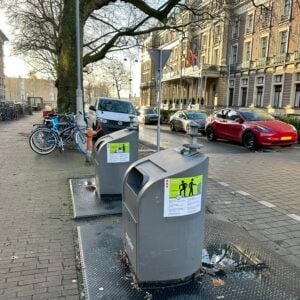

Thanks for reading.
BikePortland has served this community with independent community journalism since 2005. We rely on subscriptions from readers like you to survive. Your financial support is vital in keeping this valuable resource alive and well.
Please subscribe today to strengthen and expand our work.
Sigh. If only I saw other people riding their bikes in LA.
I just realized something. This is how my friends & I used our bikes back in Middle School, in the early 1970s, in a small town where as free-range kids we could go anywhere.
I think the biggest reason we are not social while cycling in Portland, and the U.S. in general, is that we are forced into single-file lines, off to the side of the road, squeezed between moving traffic and car doors, squished in tiny painted bike lanes.
If we dare ride in the middle of the lane, side-by-side, or if we seem to not be riding as fast as we possibly could, we incur the righteous indignation of the rest of the population driving automobiles, put out that they have to slow down.
I think it does also have something to do with skill and the type of bike (it’s a whole different type of social cycling when you have another person on your bike, for instance – not too many people doing that on racing bikes), but I think for the most part it’s simply that most people just don’t feel they can relax while riding, because the minute you relax is the minute you get hurt.
Dave you are correct that the culture of the US of A has much to do with how we ride. Roads are perceived as being for transportation and that is primarily true. Drivers don’t have the right to deny cyclists the use of roads, but “share the road” goes both ways.
That said, cars have their freeways where bikes are not allowed and cyclists should have their cycle tracks where riders can ride at what ever pace suits them. Still the bike lane on road is the model we now have, and it is not just motorists that socializing cyclists impeed. Cyclists using the bike paths for transportation are also imposed upon by dawdling riders. Jonathan may find the skill of riders in Amsterdam at a high level because they can chat or use a cell phone while riding, but this isn’t Amsterdam and everyone who uses roads for transportation is better off if the socializing takes place out of traffic.
Yes, exactly! Riding defensively in traffic is so stressful and tiring (at least for me) that I don’t have enough focus left to try and carry on a conversation.
Sound is an important aspect. Cars are really loud. I live on a 25mph street (N Denver) which was the lowest possible limit until recently (when 20mph was approved for greenways) and it’s still very hard to carry on a conversation while walking on the sidewalk, especially with young children who don’t yet understand the need to raise their voices. Compared to strolling down a quiet street, it’s a miserable experience. Your senses are constantly being assaulted.
man oh man, those are some healthy and happy looking people!
Actually, they smoke like chimney’s and burn few calories biking around town, so not so much.
I also notice there aren’t any drop handlebars in any of the image here.
you may be interested to hear that vintage road bikes are trending in Amsterdam, all with drop bars 🙂
And not a single helmet to be seen. All riding bicycles with just the wind in their hair….Those crazy Europeans!
I wish it was like this in Austin. We’re trying, but for the most part, cars rule. The “social” part of the title is what caught my eye. A website that was founded in Austin is trying to make cycling (and other sports) more social. Gritness is the name, http://www.gritness.com. Grant it, it refers to cycling as workout and the above pictures suggest that is the last thing on people’s mind in Amsterdam. Heck, I don’t see a single helmet and that scares me. Perhaps it is just a US thing.
I would think that a lot of the reason cycling is less social here in Portland (and probably everywhere else in the US, really) is just largely a cultural thing. Americans want to get there, get there as soon and as efficiently as possible, and socializing means we don’t get to do that.
Also, I do think that cycling is still viewed as more sport here than looked at as a way to get from point a to b. While it’s changing, I still think that it is widely viewed primarily for “those athletic types!!”
When I visited my brother in Sweden he got upset at me for always cycling either in front of or behind him. He said it was okay to ride side-by-side there and that struck me as odd. In LA I’m so used to the streets being too loud and bike lanes being so narrow at we don’t have the choice to converse with friends as we ride. Also, a factor that makes cycling more sociable in the bike friendly Northern Europe is that cyclists stop less frequently than they do here. In LA the intersections are timed for cars so I find myself either pedaling hard to catch the lights or I stop so much that I can’t get into a comfortable, hassle-free pedaling. By contrast in Malmo, Sweden I’ve noticed that bikes seldom need to stop when going places (due to under-passes, free right turns at intersections, bypassing intersections altogether, etc..) so people can get comfortable, and pedal slowly, carry a conversation, but still reach places just as fast as people covering the same distance in American cities.
Riding side by side happens here all the time (Vancouver, BC.) I notice with experienced cyclists they just naturally do it and one automatically falls back in line behind when there’s someone passing or coming from the front, without even arranging a protocol. People new to cycling tend to have these weird conversations where they’re yelling at you from behind or in front. I try to tell them it’s okay to cycle beside me if we’re going to talk but it seems “wrong” to them. Well, at first. There’s much more to learn about cycling than just balancing and hand signals.
So in BC, it’s technically not allowed but I doubt that it’s enforced. There is a movement to change the law to allow two-abreast cycling. That will be good.
It’s such a drag when something is good and harmless but is illegal. It just makes all the other laws that do make sense viewed as meaningless and potentially ignorable.
The real reason it “looks” the way it does in Copenhagen and Amsterdam is because cycling is an ingrained part of their “CULTURE” and has been for much longer then most of us have been alive. These people didn’t just start “ridin’ and smilin'” in their cool clothes the day before Jonathan arrived. They’ve been “ridin’, smilin and pimpin'” for decades. That’s why it looks so perfect to us and yes, it does indeed look perfect. Not one shot shows anyone doing the quick “over the shoulder glance back” in fear of impending vehicular doom. No worries of aggro cycling geeks comin’ through intersections without stopping or at least paying a bit of attention to those cyclists around them. I didn’t see garbage or potholes, weird sewer grates or glass in the streets in any of the photos either, all things we deal with, have to be careful of and cause us to be a bit more “focused” on getting from point A to point B safely as opposed to a leisurely pedal through the city. Helmets? Please, if everyone, including both drivers and cyclists, in Portland, were as comfortable, welcoming and chill as it seems everyone over there in cycling “Disneyland” is then I wouldn’t wear a helmet either. Just seeing everyone without “crash” helmets gives everyone else a sense of security. Isn’t that an “odd” thing to say or way to look at not wearing helmets. But it’s true. I didn’t notice one photo that showed a person who looked to be in any kind of hurry to get anywhere, amazing! The most impressive part of visiting and cycling in Europe to me is the CONSISTENT culture of cycling. It isn’t just incredible in cities such as these but venturing out into the countryside you’ll find that cyclists are not just an accepted part of the landscape but an expected part. Cars give you a wide berth and you feel as though you belong there just like a car does. And no, not in every single country is this the way it is but for the most part cycling into the countryside is a very pleasant, non-threatening experience. Even with ultra narrow roads, some look as though they’re paved goat paths and yet, drivers still respect cyclists when passing or approaching. It’s a culture, it’s not even a “lifestyle” to these folks, it’s just the way it is because they think it should be. Many years ago they realized they’d all be better off if this crazy form of alt transportation was respected, planned for and around and those in charge of infrastructure took the importance of cycling seriously.
It’s great Jonathan had the opportunity to visit these cities who’ve got it nailed in regards to cycling. We all appreciate you bringing your experiences to us Jonathan. Hopefully it’ll make all of us work a bit harder, vote a bit smarter and raise our voices a bit louder if we ever hope to see Portland become an urban cycling utopia such as these cities. We just need to keep in mind that it didn’t happen over a long 3-day holiday weekend in Copenhagen. It happened through many years of planning combined with an amazing vision of what was and is possible when cities want to be and do their best. Portland has a culture. It’s not where we want it to be but it’s “where it is” because not enough of us want it bad enough or say it loud enough or vote smart enough. I’m 55, I’d like to believe I’ll be a part of the current cycling “culture” that helps pave the way for my grand or great grand kids to enjoy an Amsterdamlike cycling experience as they ride through Portland many years from now. Don’t think of how it affects “you”, think of how We can affect those who come after us and who also enjoy our two-wheeled passion. Who knows, decades from now we could known as Portland”dam” as opposed to Portlandia…
Spectacular! My spouse and I ride side bi side while on the neighborhood greenways, but the main bike lanes, etc are too narrow and too close to traffic for it to make sense. I would love to see that change.
“Experience as an ECONOMIC tool” — how profoundly Dutch and Amsterdam! Yes, biking helps create a city environment that is good for business, economic development, talent recruitment. Capitalism has flourished in Amsterdam since the 13th Century, biking is now helping on that front in the 21st. The Dutch are many things, stereotypically “practical” is certainly one of them.
YESSS!! I hope you’ve gone by the Magere Brug at noon to enjoy the almost silent speed of those Dutch “swimming” by on their bikes. Thanks for the report and the pictures. What a treat…
Nice photos…makes it hard to work in the office here in Vancouver today…wish to be back in the NL cycling to minicamping or Vekabo farm sites. http://www.vekabo.com/index.php
All of the street design issues you mention are important plus traffic speeds – keeping the speed differential between cars and bikes to a minimum. And this joined with the higher threshold for responsibility after a crash placed on motor vehicle drivers…makes for streets with less sever injuries if something goes wrong or someone errs.
The margin of error here in the US on most of our urban and suburban arterials is too thin for many bike trips to be safe and secure (pleasant).
Perhaps this is also why drivers have such a backlash against sharing the roads with the growing cyclist traffic volume…they just cannot verbalise it well…plus not understanding how we have to operate in our patchwork of facilities and barriers.
…plus where is a photo of that wonderful typical Amsterdammer scene …the one with the boy friend and girl friend sharing a ride on an oma fietsen – with one sitting side saddle on the back rack…typically in a dress and with high heels. 😉
something like:
– http://www.flickr.com/photos/amsterdamize/8668883936/
– http://www.flickr.com/photos/amsterdamize/8542392234/
– http://www.flickr.com/photos/amsterdamize/8542386378/
– http://www.flickr.com/photos/amsterdamize/8384485360/
– http://www.flickr.com/photos/amsterdamize/8384465766/
?
Sorry, we had quite a lousy spring until Jonathan arrived, he struck gold, really 🙂
This is the most gorgeous thing I’ve seen in ages. The only time I’ve ever ridden side-by-side with a companion in Portland is on very quiet NE side streets, and even then, we never go more than three blocks without a “Here comes a car. You go ahead” break in the conversation.
The pictures remind me of the smiles of Sunday Parkways.
Ran into a friend on N. WIlliams, and tried having a conversation with her while hugging the right side of the bike lane. It was kind of sketchy, since the lane is so narrow, and the presence of parked cars to my right gets me thinking about being doored. It would be a breath of fresh air to have a little more room on the roads to have those conversations. Thanks for sharing Jonathan!
One important social skill in a Dutch city is to be able to wrap up your conversation with the person you’re riding with so that you’re done by the time your routes diverge. If you’re done too quickly, you can’t really start a new conversation, and if you’re not done by the time you reach the junction, you might have to stop to wrap things up.
I used to live on a corner where two major cycle routes diverged and I can’t count the number of weekend nights I’ve been kept awake by drunks loudly finishing up their reminiscences.
Note that Dutch law specifically allows for people to ride two abreast, regardless of road conditions.
Todd…Thanks for the camping tip. And another easy intermodal commute from Central Station in Adam is Gasper campgrounds at the end bound metro tram. With earplugs camping can be even better too. http://www.gaaspercamping.nl/ Worked in the NL in the 70’s and have revisited since and was blown away in 04 by the increase of cycling. Upstream here in Spokane we’re twenty years behind Portland and a century behind what the Dutch have achieved. One excellent book that Jonathan has recommended on the cycling experience in the NL was just published In the “City of Bikes Amsterdam Cyclist” by Pete Jordan and id a good read for anyone interested in the history of cycling in Amsterdam.
If we ride 2 aside here (in the few bike lanes that are wide enough to do so), we’ll probably get yelled at by cat 6 commuters racing their way…to work.
I ride two abreast here pretty frequently here in Portland. On the east side where I live, I generally ride on facilities where this is comfortable (greenways & other n’hood streets). Once in a while a driver in a hurry beeps at us or something but overall I’d say it’s quite nice.
Nice article and great pics! Side by side riding is difficult in most US bike facilities because they are narrow AND we have to worry about a potential conflict on both sides of us: to our left is moving traffic (usually at stressfully high speeds) and to our right is the potential for a car door to open. When you throw in double parking, parking maneuvers, taxi drop-offs, etc, we have to worry about conflict to our left, right, and right in front of us, even when in a bike lane. Thankfully, we seem to be moving towards facilities that are more protected and shielded from conflicts.
Generally biking in Portland feels extremely individualistic, almost competitive at times. The bikeways into NoPo are too narrow to ride two abreast and too noisy to have a conversation. Not sure if I would want to ride a dutch bike up Interstate or Greeley with any frequency. If you deter onto a side street once up the hill you can take it more leisurely.
Jonathan, after reading all the anti-bike rhetoric this week out of LA and NYC I’m curious what the nay sayers of bikes on where they are so commonplace have to say.
This one is my favorite: http://www.flickr.com/photos/bikeportland/8929797292/
Lovely.
Did you ever notice people tend to talk about difficult things a lot easier when they’re busy doing something that doesn’t require all their attention? In NL, riding side by side is not just allowed, but considered standard bicycling behavior, and is, as such, promoted by the infrastructure (for instance wide bicycle paths, at a distance from other traffic). Bike trips at a leisurely pace are a very good way to get to know someone a bit better, to talk things over, to recap the day, and to socialize. And if you haven’t got someone else with you, for clearing your mind, letting off some steam, and/or sing aloud!